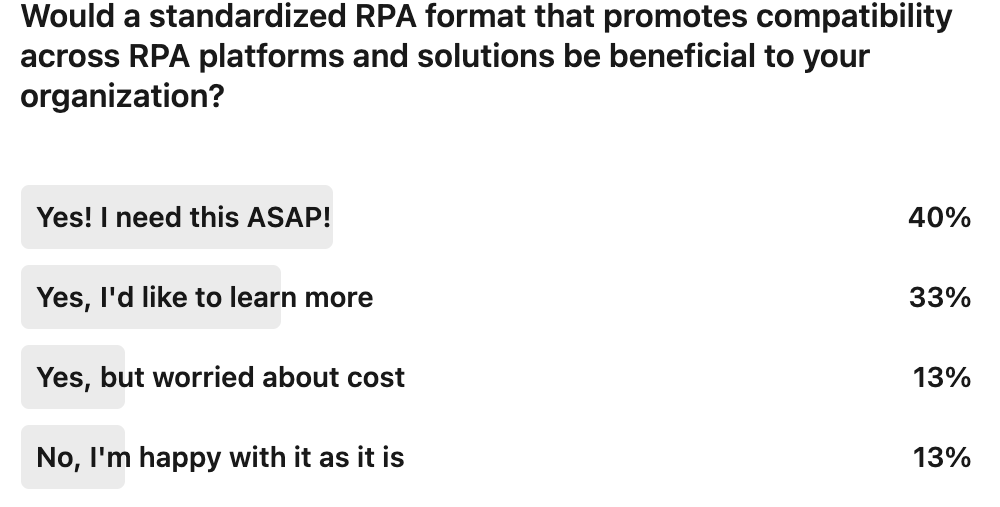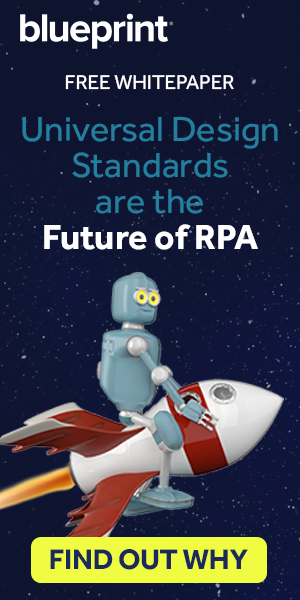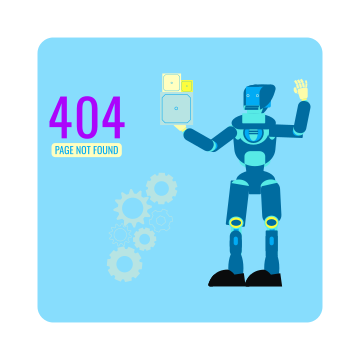The 3 Ways a Lack of RPA Standards Impacts All RPA Programs
Recently, we put forward a strong case for RPA (Robotic Process Automation) design standards. In other words, an industry-wide RPA framework that standardizes how the details of process automations are specified. As of today, the absence of well-defined, common specifications for automation continues to cast a heavy shadow over the entire automation market. We even ran a poll to gauge if this was something the market needed, and according to the results, the need is definitely real.

With all RPA platforms and the complementary tools that occupy the different points along the automation value chain (like process discovery, process/task mining, and iBPMN tools) speaking a different language, RPA programs are forced to make do with the different ways process automations are described and detailed.
The negative consequences that a lack of RPA design standards creates for the entire market are already plainly evident. Here are the three doing the most damage.
1. Being Handcuffed to Your RPA Tool as a Result of No Portability
Portability in this context refers to the ability to open, read, and action automation files in any RPA platform. The major RPA vendors have their own proprietary way to detail process automations, limited to those platforms.
A good analogy for this is that there is no equivalent .docx that can be opened in any word processing tool or .xlsx that can be opened and modified in any of the most common spreadsheet tools, whether it be Microsoft Excel, Google Sheets, or Apple Numbers.
Without something akin to the gold standard for portability – the Portable Document Format or more commonly known as the PDF – RPA programs must wrestle with two hard truths:
- They are locked into whatever RPA platform they currently use
- If their RPA tool were to go under, the consequences could be dire
 Without portability, any automation program that might want to switch RPA vendors for any number of reasons – whether it be an appealing alternate platform, disappointment with their returns to date, or incompatible version upgrades – understands it can be nearly impossible.
Without portability, any automation program that might want to switch RPA vendors for any number of reasons – whether it be an appealing alternate platform, disappointment with their returns to date, or incompatible version upgrades – understands it can be nearly impossible.
Without a common design standard for automation that is universally understood by all tools, migrating digital workforces in most cases means building them from scratch. Building bots from scratch is an endeavour too time-consuming and costly that it’s deemed a non-starter before any more serious thought can be given to such an ambition.
The risk becomes even sharper for RPA programs that have hitched their automated horses to smaller RPA studios and orchestrators.
If those platforms have the misfortune of ceasing to exist, their users would be stuck between a proverbial rock and a hard place—their portfolio of bots could not simply be ingested and operable in another platform. They would instead need to rebuild each bot from the ground up.
2. Stalled Automations Pipelines Due to the Lack of Compatibility and Inter-operability
Stalled automation pipelines are a common challenge many RPA programs struggle with. Most attribute it to:
- Weak RPA governance
- Not following RPA best practices when it comes to identifying and prioritizing automation candidates
- Or the crippling burden of RPA maintenance and support due to ineffective dependency mapping and reactive change management.
Those certainly are contributors; however, few would also indicate that a lack of RPA design standards is also part of the problem.
Process discovery tools, for example, describe process automation in their own way. There is a labour-intensive effort needed to transcribe the processes before they can start to be developed and deployed in the target RPA platforms because the data in one system isn’t compatible and operable in another.
In the absence of RPA design standards that detail process automations in a universally understood manner, process discovery tools become a significant component of stalled pipelines in the role they play for RPA candidate identification.
3. Throttled Market Growth
The returns organizations have seen from RPA are undeniable, and even though forecasts continue to project exponential growth, RPA programs still fail to scale and deliver on their objectives to maximize ROI. The inability of automation initiatives to capture the value they expected only serves to stifle the entire market's growth.
There are already commonalities in the data that drives automation. Establishing industry-wide RPA design standards could connect the commonalities in the data into specifications that all tools can universally understand.
The by-product would be the ability to design an automation only once and run it in any RPA tool you choose, or capture current-state processes using process mining and process discovery tools without the effort needed to transcribe those processes so that the target tool can make sense of it.
Consequently, market spend and growth would accelerate even more as a result of increased returns. Well-defined RPA design standards that move the needle closer to the PDF benchmark would unlock the entire market and take it to new levels of investment and value capture.
Learn more: How Universal RPA Design Standards Can Increase Automation ROI
How Blueprint is Leading the Charge for RPA Standards
At Blueprint, the need for an established set of RPA design standards has been evident for a while and is in the DNA of the Digital Blueprint. Digital Blueprints contain everything RPA programs need to deliver higher-quality automations, including:
- Detailed process flows that can be decomposed into increasingly granular levels of detail
- Dependencies related to systems or compliance regulations
- Functional and non-functional requirements
- Automatically generated user stories and both functional and acceptance tests, among other critical information needed for sustainable, scalable solution delivery
But they are also the first major step towards creating the inter-operability, portability, and set of RPA design standards that benefit everyone.
Blueprint’s Enterprise Automation Suite seamlessly slides into the middle of any automation toolchain. It provides the ability to ingest processes from a myriad of process discovery, process/task mining, and all major RPA tools themselves.
The processes themselves are ingested and converted into a common format, known as a Digital Blueprint.
Because of Blueprint’s bi-lateral integrations with all the major RPA platforms, Digital Blueprints can then be automatically synced with the RPA tool you use to drive a scalable, high-quality enterprise-wide RPA model.
Through the integrations Blueprint provides and the common format we’ve developed, it also means we’re able to facilitate the migration of entire digital workforces between the major RPA tools, unlocking the market and also acting as the translator for the cascade of automation tools speaking a different language.
Read the RPA platform migration datasheet and discover the strides Blueprint has already made towards establishing a set of RPA standards so desperately missing from the RPA landscape.
Share this
Recent Stories

Making the Case for RPA Standards

How Universal RPA Design Standards Can Increase Automation ROI

